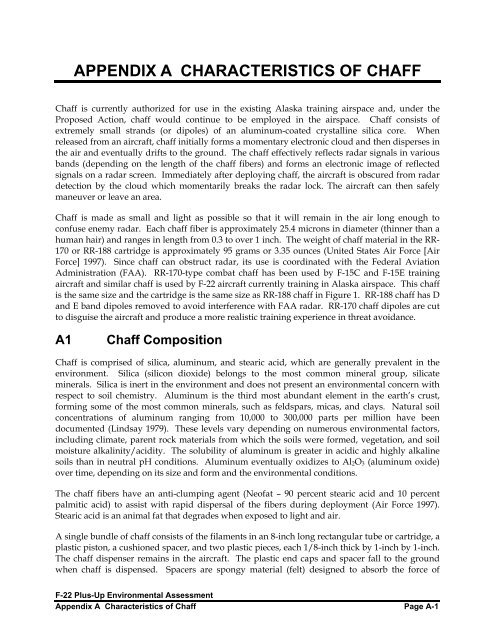F-22 Plus-Up Environmental Assessment - Joint Base Elmendorf ...
F-22 Plus-Up Environmental Assessment - Joint Base Elmendorf ...
F-22 Plus-Up Environmental Assessment - Joint Base Elmendorf ...
Create successful ePaper yourself
Turn your PDF publications into a flip-book with our unique Google optimized e-Paper software.
APPENDIX A CHARACTERISTICS OF CHAFF<br />
Chaff is currently authorized for use in the existing Alaska training airspace and, under the<br />
Proposed Action, chaff would continue to be employed in the airspace. Chaff consists of<br />
extremely small strands (or dipoles) of an aluminum-coated crystalline silica core. When<br />
released from an aircraft, chaff initially forms a momentary electronic cloud and then disperses in<br />
the air and eventually drifts to the ground. The chaff effectively reflects radar signals in various<br />
bands (depending on the length of the chaff fibers) and forms an electronic image of reflected<br />
signals on a radar screen. Immediately after deploying chaff, the aircraft is obscured from radar<br />
detection by the cloud which momentarily breaks the radar lock. The aircraft can then safely<br />
maneuver or leave an area.<br />
Chaff is made as small and light as possible so that it will remain in the air long enough to<br />
confuse enemy radar. Each chaff fiber is approximately 25.4 microns in diameter (thinner than a<br />
human hair) and ranges in length from 0.3 to over 1 inch. The weight of chaff material in the RR-<br />
170 or RR-188 cartridge is approximately 95 grams or 3.35 ounces (United States Air Force [Air<br />
Force] 1997). Since chaff can obstruct radar, its use is coordinated with the Federal Aviation<br />
Administration (FAA). RR-170-type combat chaff has been used by F-15C and F-15E training<br />
aircraft and similar chaff is used by F-<strong>22</strong> aircraft currently training in Alaska airspace. This chaff<br />
is the same size and the cartridge is the same size as RR-188 chaff in Figure 1. RR-188 chaff has D<br />
and E band dipoles removed to avoid interference with FAA radar. RR-170 chaff dipoles are cut<br />
to disguise the aircraft and produce a more realistic training experience in threat avoidance.<br />
A1<br />
Chaff Composition<br />
Chaff is comprised of silica, aluminum, and stearic acid, which are generally prevalent in the<br />
environment. Silica (silicon dioxide) belongs to the most common mineral group, silicate<br />
minerals. Silica is inert in the environment and does not present an environmental concern with<br />
respect to soil chemistry. Aluminum is the third most abundant element in the earth’s crust,<br />
forming some of the most common minerals, such as feldspars, micas, and clays. Natural soil<br />
concentrations of aluminum ranging from 10,000 to 300,000 parts per million have been<br />
documented (Lindsay 1979). These levels vary depending on numerous environmental factors,<br />
including climate, parent rock materials from which the soils were formed, vegetation, and soil<br />
moisture alkalinity/acidity. The solubility of aluminum is greater in acidic and highly alkaline<br />
soils than in neutral pH conditions. Aluminum eventually oxidizes to Al 2 O 3 (aluminum oxide)<br />
over time, depending on its size and form and the environmental conditions.<br />
The chaff fibers have an anti-clumping agent (Neofat – 90 percent stearic acid and 10 percent<br />
palmitic acid) to assist with rapid dispersal of the fibers during deployment (Air Force 1997).<br />
Stearic acid is an animal fat that degrades when exposed to light and air.<br />
A single bundle of chaff consists of the filaments in an 8-inch long rectangular tube or cartridge, a<br />
plastic piston, a cushioned spacer, and two plastic pieces, each 1/8-inch thick by 1-inch by 1-inch.<br />
The chaff dispenser remains in the aircraft. The plastic end caps and spacer fall to the ground<br />
when chaff is dispensed. Spacers are spongy material (felt) designed to absorb the force of<br />
F-<strong>22</strong> <strong>Plus</strong>-<strong>Up</strong> <strong>Environmental</strong> <strong>Assessment</strong><br />
Appendix A Characteristics of Chaff Page A-1
















